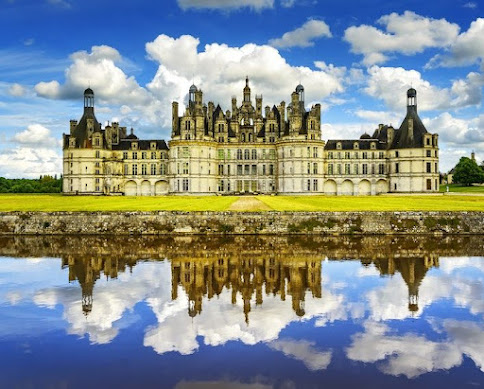Floating slowly, and silently, down the Loire River, spanning 280 km, (170 mi.) is quite a luxury all its own.
=====================================================================(in central France) The Loire Valley is a region known for its attractive landscapes and historic châteaux. The Loire River, the longest river in France, rises in the southern Massif Central and flows north and west to the Atlantic Ocean. (The valley is sometimes called the Garden of France.)
+ Visiting the Loire Valley will likely exceed your expectations (no matter how great they may have been before arriving here). Poised on the crucial frontier between northern and southern France, and just a short train (or automobile) ride from Paris, the region has long been of immense strategic importance. Kings, queens, dukes, and nobles came here to establish feudal castles and, later on, sumptuous pleasure palaces -- which explains why this fertile river valley is dotted with hundreds of France's most opulent aristocratic estates. With crenellated towers, soaring cupolas, and glittering banquet halls, the region's châteaux (and the villages and vineyards that surround them), attest to more than a thousand years of architectural and artistic creativity. The Loire Valley is also known for its outstanding wines (red, white, rosé, and sparkling) and lively, sophisticated cities, such as Orléans, Blois, Tours, and Angers -- even greater reasons why the entire area has been designated a UNESCO World Heritage Site.
+ Like many contemporary regions of France, the region of Centre-Val de Loire was created from parts of historical provinces: Touraine, Orléanais, and Berry. On 17 January 2015, as part of the reorganization of French regions, this one's official name was changed to Centre-Val de Loire. The Val de Loire is associated with positive images of the Loire Valley, such as the châteaux, the gentle and refined lifestyle, wine, as well as the mild and temperate climate, all of which attract lots of tourists to this region.
+ For centuries, the Loire Valley was a strategic frontier and a playground for royalty and nobility, who built hundreds of lavish châteaux along the river banks. With its 2,500 listed monuments, the valley attracts nine million visitors annually, due to its wealth of unspoiled landscapes (many of the most visited châteaux in France (like Chambord and Chenonceaux), its wine heritage (as the third largest wine-growing region in France), and its many recreational and nature destinations (like Beauval Zoo, Center Parcs holiday village, and the Loire à Vélo cycle route).
+ The Loire Valley is also widely considered a living laboratory: Leonardo da Vinci designed his weirdest inventions here, and kings made it the crucible of the French Renaissance. Clinging to the riverbanks, the Chateau de Chambord (shown here) and its neighbors convey the fabulous story of this artistic effervescence -- also expressed by gardens such as those at Chaumont-sur-Loire, which is both a chateau and the landscape laboratory of the future.





No comments:
Post a Comment